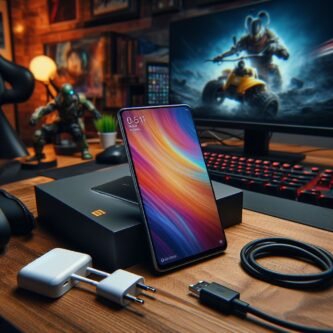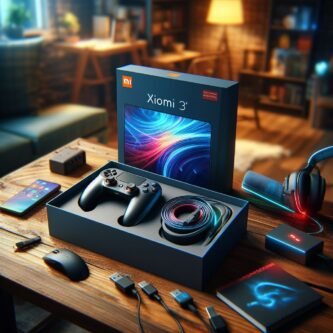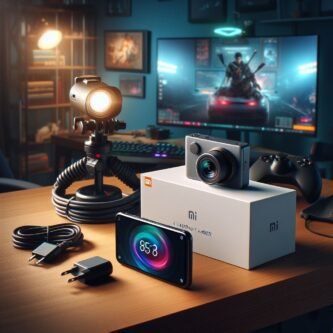The compact Xiaomi 14 is a little high-flyer with some impressive features. It has excellent battery life, super-fast charging (90 watts), and three Leica cameras, one of which has 50 megapixels. The screen is super bright (3000 nits) and runs really smoothly (120 Hz). But the coolest part is the latest Snapdragon 8 Gen 3 chip from Qualcomm. Is this smartphone perfect?
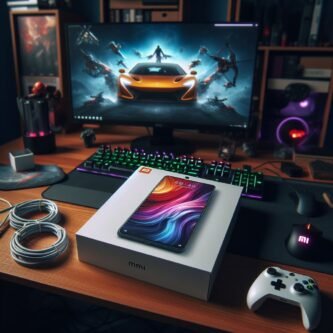
Most top-performing smartphones are big, around 6.7 inches or more. But Xiaomi is doing something different. The Xiaomi 14, like the Xiaomi 13, stays compact at 6.36 inches. And it’s not just small, it’s powerful too. With the new Snapdragon 8 Gen 3, the Xiaomi 14 is one of the fastest smartphones you can get.
The Xiaomi 14 has a new camera system along with the new Snapdragon chip. Unlike the Xiaomi 13, which used the Sony IMX800, the main camera in the Xiaomi 14 uses something called the Light Fusion 900 sensor. It’s big, about 1/1.31 inches, and it’s probably made by a company called Omnivision. Also, the main, wide-angle, and telephoto cameras all have a 50-megapixel resolution now.
Table of Contents
As of now, you can only get the Xiaomi 14 officially in China. If you’re outside China and want one, you’ll have to buy an imported version. But don’t worry if you’re in Europe – a global version is on its way, expected sometime in the first quarter of 2024. Rumors online suggest it might arrive on February 25th, just before the Mobile World Congress begins in Barcelona.
Xiaomi 14 Specifications
- Processor: Qualcomm Snapdragon 8 Gen 3
- Graphics: Qualcomm Adreno 750
- Memory: 12 GB LPDDR5X RAM
- Display: 6.36-inch OLED screen with HDR10+, Dolby Vision, and 120 Hz refresh rate
- Storage: 256 GB UFS 4.0 Flash
- Connections: USB-C, HDMI, DisplayPort, fingerprint reader, NFC, various sensors
- Networking: Wi-Fi 7, Bluetooth 5.4, 2G/3G/4G/5G support, GPS
- Size: 152.8 x 71.5 x 8.2 mm
- Battery: 4610 mAh with wireless charging and fast charging
- Operating System: Android 14
- Camera: Main (50 MP), Telephoto (50 MP), Ultrawide (50 MP), Front (32 MP)
- Additional Features: Stereo speakers, waterproof, 90W charger included
- Weight: 193 g (device), 97 g (charger)
- Price: 700 Euros
potential competitors for comparison:
| Rating | Date | Model | Weight | Drive | Size | Resolution | Best Price |
|---|---|---|---|---|---|---|---|
| 89.8% | 01/2024 | Xiaomi 14 | 193 g | 256 GB UFS 4.0 Flash | 6.36″ | 2670×1200 | – |
| 89.1% | 10/2023 | Apple iPhone 15 | 171 g | 128 GB NVMe | 6.10″ | 2556×1179 | from EUR 949 |
| 90.5% | 03/2023 | Samsung Galaxy S23 | 167 g | 128 GB UFS 3.1 Flash | 6.10″ | 2340×1080 | from EUR 949 |
| 89.0% | 09/2023 | Sony Xperia 5 V | 182 g | 128 GB UFS 3.1 Flash | 6.10″ | 2520×1080 | from EUR 999 |
| 89.1% | 02/2023 | Xiaomi 13 | 189 g | 256 GB UFS 4.0 Flash | 6.36″ | 2400×1080 | from EUR 0 |
| 89.4% | 12/2023 | Xiaomi 14 Pro | 223 g | 256 GB UFS 4.0 Flash | 6.73″ | 3200×1440 | from EUR 780 |
The Xiaomi 14 features a glass and aluminum
The Xiaomi 14 comes in black, white, and green colors in China, with a possible pink nano-leather version for Europe. The glass version weighs 193 grams, while the leather one is lighter at 188 grams.
The glass variant has Corning Gorilla Glass Victus on the display and back, but it easily attracts fingerprints. The aluminum frame also gets smudged easily. The SIM slot cover is aluminum and fits nicely with the frame. Overall, the build quality is good with narrow and even gaps.
Compared to Xiaomi 13, the camera module on Xiaomi 14 is larger, protruding about 4 millimeters from the back. It includes an infrared transmitter, a microphone, and an LED flash. The big camera prevents the phone from wobbling on a flat surface. The Xiaomi 14 is IP68-certified, making it dust and waterproof.
Size comparison
| Model | Length (mm / inch) | Width (mm / inch) | Thickness (mm / inch) | Weight (g) | Weight (lbs) |
|---|---|---|---|---|---|
| Xiaomi 14 Pro | 161.4 / 6.35 | 75.3 / 2.96 | 8.49 / 0.3343 | 223 | 0.4916 |
| Sony Xperia 5 V | 154 / 6.06 | 68 / 2.68 | 8.6 / 0.3386 | 182 | 0.4012 |
| Xiaomi 14 | 152.8 / 6.02 | 71.5 / 2.81 | 8.2 / 0.3228 | 193 | 0.4255 |
| Xiaomi 13 | 152.8 / 6.02 | 71.5 / 2.81 | 7.98 / 0.3142 | 189 | 0.4167 |
| Apple iPhone 15 | 147.6 / 5.81 | 71.6 / 2.82 | 7.8 / 0.3071 | 171 | 0.377 |
| Samsung Galaxy S23 | 146.3 / 5.76 | 70.9 / 2.79 | 7.6 / 0.2992 | 171 | 0.377 |
Xiaomi 14 Equipment: USB-C 3.2 Gen. 1 Compatibility
The Xiaomi 14’s USB-C port operates at USB 3.0 speed, a notable upgrade from the Xiaomi 13’s USB 2.0 port. This improvement is evident during data transfers with external storage devices. In a test using the Samsung 980 Pro M.2 SSD in the Asus ROG Strix Arion Case (USB 3.2 Gen. 2), the Xiaomi 14 achieved a solid transfer rate of 311.7 MB/s.
However, the Xiaomi 14, like its predecessor, lacks an audio jack and a microSD slot. Instead, it features an IR blaster for remote control of compatible devices like TVs, integrated within the camera unit. Bluetooth 5.4 and NFC capabilities are also included.
In China, the Xiaomi 14 comes in four storage options: 8/256 GB, 12/256 GB, 16/512 GB, and 16/1024 GB. It’s uncertain if all storage variants will be available globally.
Software – Xiaomi 14 Operating System: HyperOS based on Android 14
The Xiaomi 14 comes with Xiaomi’s new HyperOS, which is built on Android 14. This operating system combines Linux with the Vela IoT platform, promising some significant advancements, though they may not be immediately noticeable. In practice, HyperOS looks very similar to the previous MIUI user interface, with only minor visual and menu changes. This means users won’t have to learn anything new to navigate the phone.
Xiaomi commits to providing software updates for the Xiaomi 14 for 4 years, with Android security patches scheduled for 5 years. However, it’s unclear how frequently these updates will be released. Our test device had the latest security patch from December 1, 2023.
The Hyper-OS ROM in the Chinese version supports limited languages, including English. With DRM certification for Widevine L1, the Xiaomi 14 can stream web content in HD quality.
The Chinese version doesn’t come with the Google Play Store pre-installed. However, it’s easy to install using Xiaomi’s GetApps app store, as the Google framework and related services are already running in the background.
Users might want to install a keyboard like Google Gboard from the Play Store since the pre-installed keyboards (Baidu IME, Sogou Keyboard, and iFlytek IME) are designed for Chinese users and might not be ideal for QWERTZ/QWERTY keyboard layouts.
Communication and GNSS – Xiaomi 14’s WiFi 7 Support
The Xiaomi 14 boasts WiFi 7 compatibility, the latest and fastest Wi-Fi standard available (also known as IEEE 802.11be). This theoretically allows for transfer rates of up to 46 GBit/s, although we haven’t been able to confirm this due to the absence of compatible routers.
Despite this, even with WiFi 6E, the Xiaomi 14 offers more than enough performance for everyday use. When paired with our Asus ROG Rapture GT-AXE11000 reference router, the smartphone achieves high and mostly stable transfer rates in the 6 GHz band, peaking at just under 1740 MBit/s.
In our imported model, the cellular frequencies are optimized for the Asian market. While 5G support for the European region is comprehensive, there are gaps in 4G coverage. Notably, LTE band 20, important in many countries, is absent, potentially causing reception issues, especially in rural areas.
However, with the official launch of the Xiaomi 14 in Europe and the US, these limitations should disappear. Xiaomi typically equips the global versions of its smartphones with a broader range of frequencies, providing better coverage and compatibility.
Networking Data
| Device | Test Type | Transfer Rate (MBit/s) | Minimum Transfer Rate (MBit/s) | Percentage |
|---|---|---|---|---|
| Xiaomi 14 | Receive AXE11000 | 1623 | 1502 | ∼95% |
| Xiaomi 14 | Transmit AXE11000 | 1716 | 1119 | ∼96% |
| Xiaomi 14 | Transmit AXE11000 6GHz | 1738 | 1597 | ∼92% |
| Xiaomi 14 | Receive AXE11000 6GHz | 1737 | 873 | ∼100% |
| Apple iPhone 15 | Receive AXE11000 | 691 | 617 | ∼40% |
| Apple iPhone 15 | Transmit AXE11000 | 773 | 576 | ∼43% |
| Samsung Galaxy S23 | Receive AXE11000 | 1659 | 1603 | ∼97% |
| Samsung Galaxy S23 | Transmit AXE11000 | 1749 | 1253 | ∼98% |
| Samsung Galaxy S23 | Transmit AXE11000 6GHz | 1799 | 1744 | ∼95% |
| Samsung Galaxy S23 | Receive AXE11000 6GHz | 1590 | 1562 | ∼92% |
| Sony Xperia 5 V | Receive AXE11000 | 838 | 818 | ∼49% |
| Sony Xperia 5 V | Transmit AXE11000 | 958 | 934 | ∼54% |
| Xiaomi 13 | Receive AXE11000 | 894 | 803 | ∼52% |
| Xiaomi 13 | Transmit AXE11000 | 770 | 459 | ∼43% |
| Xiaomi 13 | Transmit AXE11000 6GHz | 1894 | 955 | ∼100% |
| Xiaomi 13 | Receive AXE11000 6GHz | 1656 | 1620 | ∼95% |
| Xiaomi 14 Pro | Receive AXE11000 | 1717 | 1627 | ∼100% |
| Xiaomi 14 Pro | Transmit AXE11000 | 1783 | 911 | ∼100% |
| Xiaomi 14 Pro | Transmit AXE11000 6GHz | 1728 | 1374 | ∼91% |
| Xiaomi 14 Pro | Receive AXE11000 6GHz | 1731 | 1657 | ∼100% |
| Average of class Smartphone | Receive AXE11000 | 655 | 34.8 | ∼38% |
| Average of class Smartphone | Transmit AXE11000 | 688 | 40.5 | ∼39% |
| Average of class Smartphone | Transmit AXE11000 6GHz | 1542 | 229 | ∼81% |
| Average of class Smartphone | Receive AXE11000 6GHz | 1388 | 598 | ∼80% |
The Xiaomi 14 is equipped with GPS, Glonass, Galileo, and Beidou satellite systems, allowing for accurate localization. These satellites operate in dual-band mode. During testing, the smartphone consistently located itself with a precision of 3 meters, whether indoors or outdoors.
In practical use, the Xiaomi 14 accurately tracked a 10-kilometer cycling route, almost matching the performance of the Garmin Venu 2 fitness smartwatch. This level of accuracy makes the Xiaomi 14 well-suited for navigation purposes.
Telephony and voice quality of Xiaomi
The Xiaomi 14 offers 5G support and allows for dual SIM usage. It also supports WLAN calls along with VoLTE. In the imported version, the phone can record calls. However, we didn’t find an option for activating eSIMs in the settings. It’s expected that if a global model is released, it will likely include eSIM functionality.
During calls, the Xiaomi 14 provides good voice quality. Voices come through clearly, and background noise is filtered out effectively, especially when using hands-free mode.
Cameras – Triple 50 MP Camera Setup with Leica Design
The selfie camera on the Xiaomi 14 remains at 32 MP, the same as the Xiaomi 13. However, the Xiaomi 14 can now shoot 4K videos at 60 FPS, a big improvement over its predecessor, which was limited to Full HD at 30 FPS. The selfie camera captures sharp images using its full 32 MP without any reduction in quality.
Xiaomi continues its collaboration with Leica for the cameras on its high-end smartphones, including the Xiaomi 14. The main camera features a high-resolution 50 MP Summilux lens, identified by the Vario-Summilux 1:1.6-2:2/14-75 Asph marking on the camera module. The sensor, stabilized with OIS and sized at 1/1.31 inches, captures 12.5 MP photos through pixel binning and is called the Light Hunter 900, likely sourced from Omnivision.
The triple camera setup also includes a 50 MP ultra-wide-angle camera and a 50 MP telephoto camera with 3.2x optical zoom and OIS. While the Xiaomi 14 Pro shares the same triple camera setup, it offers additional features such as variable aperture control for the main camera and autofocus for close-ups with the ultra-wide-angle camera, which are not available on the Xiaomi 14.
Cooperation with Leica also influences the camera software. Inside the camera app, users have access to various image modes, including two Leica options: Leica Vibrant and Leica Authentic. These modes, accessible via an icon on the top right of the screen, offer slightly different color calibrations. Leica Vibrant enhances colors for a more saturated look, while Leica Authentic aims to replicate the original Leica color style with clear colors.
During daylight, the main camera captures sharp, detailed photos with vibrant colors and strong contrasts. Even in low light, the photos maintain decent quality. The ultra-wide-angle camera uses a similar color balance and employs 4-in-1 pixel binning, providing decent image quality. However, detail can be lacking, especially towards the edges of the frame. The telephoto camera offers up to 3.2x magnification without sacrificing quality, delivering solid images, particularly for portrait shots.
The Xiaomi 14’s main camera enables very stable video recording at up to 8K resolution and 24 frames per second. The ultra-wide-angle and telephoto cameras support recording at up to 4K resolution and 60 frames per second. Users can switch between lenses while recording videos, but this feature is limited to 4K resolution and a maximum of 30 frames per second.
Accessories and Warranty – Xiaomi 14’s Included Items
The Xiaomi 14 package includes a 90-watt power adapter (up to 20V/4.5A, plug type A), a USB cable (type A to C), a SIM tool, a protective case, and a quick start guide.
The Xiaomi 14 comes with a standard 12-month warranty.
Input Devices & Operation – Xiaomi 14’s Touch Sampling Rate
Thanks to the Snapdragon 8 Gen 3 processor and the responsive OLED panel, using the Xiaomi 14 is incredibly smooth. The 6.36-inch screen features a touch sampling rate of 240 Hz, which can go up to 2160 Hz during gaming sessions.
The physical buttons and vibration motor offer precise and crisp feedback, giving a high-quality feel. The optical fingerprint sensor embedded within the display works swiftly without any issues in recognition speed and accuracy. Additionally, users can opt for quick biometric login using the 2D facial recognition feature, which is also fast and efficient.
Display – Xiaomi 14’s Bright OLED Panel
The Xiaomi 14 boasts a 6.36-inch OLED panel with a sharp resolution of 2670 x 1200 pixels, resulting in a high pixel density of 460 pixels per inch (PPI). Alongside HDR10+, the screen also supports Dolby Vision. By default, the Xiaomi 14 adjusts the frame rate of its OLED panel based on the content being displayed, but users can manually set it to a constant 60 or 120 Hz if preferred.
The OLED panel offers impressive brightness levels. On a white background, it averages around 1051.7 cd/m², providing ample brightness for various usage scenarios. In tests with a mix of bright and dark image areas, the panel reached a very good 1569 cd/m². When playing HDR content, the screen can hit its peak brightness of 3000 nits, occasionally surpassing 3189 cd/m². With the brightness sensor turned off, the display can achieve a maximum of 528 cd/m², while the lowest brightness setting is recorded at 2.5 cd/m².
Similar to many OLED panels, the display on the Xiaomi 14 exhibits flickering. However, the flickering is relatively uniform across different brightness levels and occurs at a relatively high frequency of 429 Hz. Users sensitive to pulse width modulation (PWM) can activate the Anti-Flicker feature in the display settings. With DC dimming enabled, PWM flickering was only observed at the same level as the refresh rate across the entire brightness range.
| Smartphone | Screen | Brightness middle | Brightness | Brightness Distribution | Black Level | Colorchecker dE 2000 | Colorchecker dE 2000 max. | Greyscale dE 2000 | Gamma | CCT |
|---|---|---|---|---|---|---|---|---|---|---|
| Xiaomi 14 | OLED, 2670×1200, 6.36 | 1043 | 1052 | 96 | 1.1 | 1.4 | 2.8 | 1.9 | 2.23 | 6740 |
| Apple iPhone 15 | Super Retina XDR OLED, 2556×1179, 6.10 | 1046 | 1019 | 94 | 1.4 | 1.4 | 2.84 | 2.4 | 2.158 | 6410 |
| Samsung Galaxy S23 | Dynamic AMOLED 2x, 2340×1080, 6.10 | 1125 | 1122 | 96 | 3.2 | 4.9 | 4.5 | 3.3 | 1.97 | 6504 |
| Sony Xperia 5 V | OLED, 2520×1080, 6.10 | 889 | 898 | 97 | 1.4 | 3.2 | 4.9 | 1 | 1 | 6456 |
| Xiaomi 13 | OLED, 2400×1080, 6.36 | 1209 | 1208 | 98 | 1.2 | 1.2 | 3 | 2.1 | 2.26 | 6504 |
| Xiaomi 14 Pro | AMOLED, 3200×1440, 6.73 | 1025 | 1046 | 95 | 1.1 | 1.1 | 2.9 | 2.2 | 2.25 | 6622 |
Please note that the values for brightness, color accuracy, and other metrics are provided with their respective percentages of difference from the reference device or standard.
After conducting an in-depth analysis using Calman analysis software and a photo spectrometer, we scrutinized the OLED panel’s color reproduction capabilities. We found that the Xiaomi 14 achieves optimal image quality when the “Original” color scheme is selected in the display settings, paired with a Warm color temperature setting. In this configuration, the OLED panel utilizes the small sRGB color space, ensuring complete color accuracy.
Alternatively, in Vivid color mode, the OLED panel dynamically adjusts its colors based on the displayed content, resulting in significantly enhanced color saturation. However, this mode also expands to the larger DCI-P3 color space.
Display Response Times
Display response times indicate how quickly the screen can transition from one color to another. Slower response times may result in afterimages and make moving objects appear blurry, a phenomenon known as ghosting. For gamers who enjoy fast-paced 3D games, it’s important to consider displays with fast response times to ensure smoother and clearer visuals.
Response Time Black to White
The response time from black to white, including both rise and fall, is 1.54 milliseconds. During the rise, it’s 0.788 milliseconds, and during the fall, it’s 0.75 milliseconds. Based on our tests, the screen exhibits extremely fast response rates, making it highly suitable for fast-paced gaming.
Compared to all tested devices, which range from 0.1 to 240 milliseconds, only 3% perform better. This indicates that the measured response time surpasses the average of all tested devices, which is 21.8 milliseconds.
Response Time 50% Grey to 80% Grey
The response time from 50% grey to 80% grey, including both rise and fall, is 1.11 milliseconds. During the rise, it’s 0.5725 milliseconds, and during the fall, it’s 0.5365 milliseconds. Our tests indicate that the screen exhibits exceptionally fast response rates, making it highly suitable for fast-paced gaming.
Compared to all tested devices, which range from 0.2 to 636 milliseconds, only 2% perform better. This suggests that the measured response time surpasses the average of all tested devices, which is 34.2 milliseconds.
When using the Xiaomi 14 outdoors, its bright display shines. Even during our tests in wintry light conditions, the OLED panel remained stable in terms of viewing angles, making content easily readable without any problems. With its ample brightness reserves, we anticipate that the experience will remain excellent even during sunny summer days.
Superior Performance: Snapdragon 8 Gen 3 Powers the Xiaomi 14
The Xiaomi 14 boasts top-notch performance thanks to its Snapdragon 8 Gen 3 processor, coupled with up to 16 GB of LPDDR5X RAM (our test device has 12 GB) and fast UFS 4.0 memory. This combination makes it one of the speediest smartphones on the market today.
Compared to its predecessor, the Xiaomi 13, the Snapdragon 8 Gen 3 in the Xiaomi 14 shows significant improvements in CPU performance. For instance, in Geekbench 5.5 tests, the Xiaomi 14 demonstrates about a 14% boost in single-core performance and nearly 24% in multi-core performance compared to the Xiaomi 13. Among our comparison devices, only the Apple iPhone 15 surpasses the Xiaomi 14 in single-core performance. However, the Xiaomi 14’s AI benchmarks are similar to those of the Xiaomi 13.
Geekbench 5.5
| Device | Processor | Single-Core Score | Percentage Difference |
|---|---|---|---|
| Apple iPhone 15 | Apple A16 Bionic, A16 GPU 5-Core | 1884 Points | +26% |
| Xiaomi 14 Pro | Snapdragon 8 Gen 3, Adreno 750 | 1687 Points | +13% |
| Xiaomi 14 | Snapdragon 8 Gen 3, Adreno 750 | 1684 Points | +12% |
| Average Snapdragon 8 Gen 3 | 1664 Points | +11% | |
| Samsung Galaxy S23 | Snapdragon 8 Gen 2 for Galaxy, Adreno 740 | 1549 Points | +3% |
| Sony Xperia 5 V | Snapdragon 8 Gen 2, Adreno 740 | 1497 Points | 0% |
| Xiaomi 13 | Snapdragon 8 Gen 2, Adreno 740 | 1478 Points | -1% |
| Average of class Smartphone | 119 – 2138 Points | Last 2 years |
Note: The “Percentage Difference” represents the deviation in single-core scores compared to the average Snapdragon 8 Gen 3 score.
Multi Core
| Device | Processor | Multi-Core Score | Percentage Difference |
|---|---|---|---|
| Xiaomi 14 Pro | Snapdragon 8 Gen 3, Adreno 750 | 6439 Points | 0% |
| Xiaomi 14 | Snapdragon 8 Gen 3, Adreno 750 | 6307 Points | -2% |
| Average Snapdragon 8 Gen 3 | 6219 Points | -3% | |
| Xiaomi 13 | Snapdragon 8 Gen 2, Adreno 740 | 5090 Points | -21% |
| Sony Xperia 5 V | Snapdragon 8 Gen 2, Adreno 740 | 4998 Points | -22% |
| Samsung Galaxy S23 | Snapdragon 8 Gen 2 for Galaxy, Adreno 740 | 4974 Points | -23% |
| Apple iPhone 15 | Apple A16 Bionic, A16 GPU 5-Core | 4688 Points | -27% |
| Average of class Smartphone | 473 – 6681 Points | Last 2 years |
Note: The “Percentage Difference” represents the deviation in multi-core scores compared to the average Snapdragon 8 Gen 3 score.
In GPU benchmarks, the Adreno 750 in the Xiaomi 14 consistently performs exceptionally well, often outperforming strong rivals like the Apple iPhone 15 and the Samsung Galaxy S23. Occasionally, the Xiaomi 14 Pro, which shares the same Snapdragon 8 Gen 3 and Adreno 750 setup, narrowly surpasses the Xiaomi 14 in off-screen tests conducted by GFXBench.
This difference could be attributed to thermal issues, as our testing shows that the Xiaomi 14 tends to throttle its performance under heavy loads. The larger 6.73-inch Xiaomi 14 Pro also experiences throttling but may handle heat dissipation more effectively due to its larger cooling area.
3DMark:
- Wild Life Extreme Unlimited
- Wild Life Extreme
- Wild Life Unlimited Score
- 2560×1440 Sling Shot Extreme (ES 3.1) Unlimited Physics
- 2560×1440 Sling Shot Extreme (ES 3.1) Unlimited Graphics
- 2560×1440 Sling Shot Extreme (ES 3.1) Unlimited
GFXBench 2.7:
- T-Rex Onscreen
- 1920×1080 T-Rex Offscreen
GFXBench 3.0:
- Manhattan Onscreen OGL
- 1920×1080 1080p Manhattan Offscreen
GFXBench 3.1:
- Manhattan ES 3.1 Onscreen
- 1920×1080 Manhattan ES 3.1 Offscreen
GFXBench:
- Car Chase Onscreen
- 1920×1080 Car Chase Offscreen
- Aztec Ruins High Tier Onscreen
- 2560×1440 Aztec Ruins High Tier Offscreen
- Aztec Ruins Normal Tier Onscreen
- 1920×1080 Aztec Ruins Normal Tier Offscreen
- 3840×2160 4K Aztec Ruins High Tier Offscreen
3DMark / Wild Life Extreme Unlimited
| Device | GPU | Processor | Storage | Score | Difference |
|---|---|---|---|---|---|
| Xiaomi 14 | Adreno 750 | SD 8 Gen 3 | 256 GB UFS 4.0 | 4729 Points | 0% |
| Xiaomi 13 | Adreno 740 | SD 8 Gen 2 | 256 GB UFS 4.0 | 3707 Points | -22% |
| Samsung Galaxy S23 | Adreno 740 | SD 8 Gen 2 | 128 GB UFS 3.1 | 3699 Points | -22% |
| Sony Xperia 5 V | Adreno 740 | SD 8 Gen 2 | 128 GB UFS 3.1 | 3627 Points | -23% |
| Apple iPhone 15 | A16 GPU 5-Core | A16 | 128 GB NVMe | 2411 Points | -49% |
This table compares the 3DMark Wild Life Extreme Unlimited scores of different devices, showing the GPU, processor, storage, score, and percentage difference compared to the Xiaomi 14.
The Xiaomi 14 demonstrates impressive system speed when browsing the web, delivering excellent browser performance. In benchmark tests, it falls second only to the Apple iPhone 15 among the devices we compared.
Gaming – Xiaomi 14: Abundant Gaming Performance
With its Snapdragon 8 Gen 3 processor and a 120 Hz OLED panel boasting accurate touch input and a high sampling rate, the Xiaomi 14 is tailor-made for gaming. It handles graphically demanding games like Genshin Impact or PUBG Mobile effortlessly, maintaining smooth gameplay even at high detail settings. However, we couldn’t retrieve specific frame rates as the Xiaomi 14 didn’t cooperate with our Gamebench test tool.

Emissions – Snapdragon Chipset and Heating Concerns
The Xiaomi 14 is equipped with the Xiaomi Loop LiquidCool system to maintain stability during gaming, HD video streaming, and other demanding tasks. In everyday use, we didn’t experience any performance issues, no matter what app or game we used. However, it’s worth noting that the phone tends to heat up quickly when under heavy load.
Internally, the Snapdragon 8 Gen 3 processor sometimes pushes the Xiaomi 14’s cooling system to its limits. During tests like GFXBench Manhattan and 3DMark’s Wild Life stress tests, the phone crashed due to overheating issues. The same happened during the Burnout benchmark when running it at full load (CPU + GPU). We conducted temperature measurements under less demanding conditions (CPU only), and found that the surface temperature reached 44.2 °C, which is not dangerously high.
Speakers
The Xiaomi 14 has Dolby Atmos-certified stereo speakers, but they don’t create a strong sense of spatial sound. However, they produce well-balanced audio up to 91.4 dB(A) and reproduce voices very naturally. Like many smartphones, they lack bass tones.
You can connect external audio devices via USB-C or Bluetooth 5.4. The Xiaomi 14 supports various Bluetooth codecs including SBC, AAC, LDAC, aptX, aptX HD, aptX Adaptive, aptX TWS+, and LHDC V1 to V5.
Audio analysis Xiaomi 14 vs Samsung Galaxy
| Frequency Range | Xiaomi 14 Analysis | Samsung Galaxy S23 Analysis |
|---|---|---|
| Bass 100 – 315 Hz | Almost no bass (21.6% lower) | Almost no bass (22.5% lower) |
| Mids 400 – 2000 Hz | Balanced, close to median (3.3%) | Reduced mids, slightly lower (5.8%) |
| Highs 2 – 16 kHz | Higher highs (7.8% higher) | Balanced highs (4.5% away from median) |
| Overall 100 – 16 kHz | Average linearity (17% difference) | Average linearity (16.2% difference) |
| Loudness (dB) | Relatively loud (92.6 dB) | Relatively loud (91.5 dB) |
Comparison:
- Xiaomi 14:
- Better in bass linearity (3.8% delta).
- Balanced mids with a slight deviation (3.3% delta).
- Higher highs (7.8% higher than median).
- Relatively loud (92.6 dB).
- Samsung Galaxy S23:
- Slightly better in bass linearity (6.1% delta).
- Reduced mids (5.8% lower than median).
- Balanced highs (4.5% away from median).
- Relatively loud (91.5 dB).
Battery Life – 4610 mAh and Long-lasting Performance
Charging and Power Usage
The Xiaomi 14 boasts a robust 4610 mAh battery that supports super-fast charging up to 90 watts. You get a compatible power adapter right in the box. In our tests, the battery went from empty to fully charged in just 39 minutes, thanks to its rapid charging capability. Additionally, the smartphone offers wireless charging at speeds of up to 50 watts. It can even do reverse wireless charging, giving power to other devices, at up to 10 watts.
When it comes to power consumption, the Xiaomi smartphone is quite efficient. During idle times, it uses less than 1 watt of power, which helps conserve battery when you’re not actively using it. Even during demanding tasks like running the Burnout benchmark, it remains energy-efficient, using just over 9 watts to keep everything running smoothly.
Battery life

The Xiaomi 14 may not have the biggest battery at 4610 mAh, but it’s a champ when it comes to lasting power. When the screen brightness is set at 150 cd/m², you can surf the web for over 18 hours without needing to recharge. Plus, if you’re binge-watching videos, it can keep going for almost 28 hours straight, even with the communication turned off.
The Sony Xperia 5 V and Xiaomi 14 Pro offer similar impressive battery life. While the Xiaomi 14 Pro has a slightly larger battery, it also has to support a bigger and much higher-resolution screen.
Battery Runtime
| Idle (without WLAN, min brightness) | 48h 46min | |
| WiFi Websurfing | 18h 12min | |
| Big Buck Bunny H.264 1080p | 27h 54min | |
| Load (maximum brightness) | 4h 37min |
Battery Runtime daily
| Device | Battery Capacity (mAh) | Reader / Idle | H.264 | WiFi v1.3 | Load |
|---|---|---|---|---|---|
| Xiaomi 14 | 4610 | 2926 | 1674 | 1092 | 277 |
| Apple iPhone 15 | 3349 | 2698 (-8%) | 1305 (-22%) | 1002 (-8%) | 306 (10%) |
| Samsung Galaxy S23 | 3900 | 2249 (-23%) | 1255 (-25%) | 926 (-15%) | 370 (34%) |
| Sony Xperia 5 V | 5000 | 2788 (-5%) | 1493 (-11%) | 952 (-13%) | 371 (34%) |
| Xiaomi 13 | 4500 | 2983 (2%) | 1221 (-27%) | 1021 (-7%) | 423 (53%) |
| Xiaomi 14 Pro | 4880 | 1998 (-32%) | 1437 (-14%) | 897 (-18%) | 189 (-32%) |
This table provides data on battery capacity (mAh) and runtime performance for different activities (Reader / Idle, H.264, WiFi v1.3, Load) compared to the Xiaomi 14’s performance.
Verdict on the Xiaomi 14
The Xiaomi 14 represents a significant upgrade from its predecessor, the Xiaomi 13, with improvements across various aspects. It retains the same compact and sturdy design while offering extensive features, making it a reliable high-end smartphone for daily use.
Packed with a vibrant OLED display and remarkable battery life, the Xiaomi 14 stands out as a compact yet powerful device.
Much like its forerunner, the Xiaomi 14 boasts impressive battery longevity, an enhanced camera system developed in collaboration with Leica, and top-notch performance thanks to the Snapdragon 8 Gen 3 processor. Notably, the display has been further refined, with brightness levels exceeding 3000 cd/m² in HDR mode.
Addressing previous shortcomings, the Xiaomi 14 features a modern USB 3.0 port, faster charging capabilities of up to 90 watts, and an upgraded front camera capable of recording 4K videos at 60 frames per second— a significant enhancement from the Xiaomi 13, which was limited to full HD at 30 FPS.
However, there are a couple of drawbacks. The Snapdragon 8 Gen 3 processor tends to generate heat under heavy loads, pushing the device to its thermal limits. Prospective buyers awaiting the global version of the Xiaomi 14 can anticipate improvements like enhanced cellular frequency coverage, including LTE band 20, and eSIM support.
In comparison to the Xiaomi 13, alternatives such as the Apple iPhone 15 and the Samsung Galaxy S23 offer similar speed, compactness, impressive cameras, and commendable battery life.
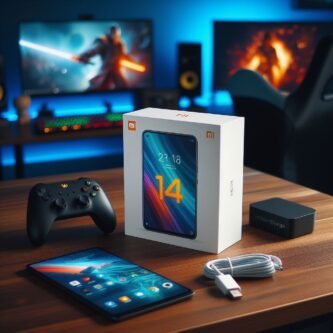
Price and availability
The Xiaomi 14 is currently available as an import outside of China. For instance, Giztop offers the smartphone at a price of $669.99, excluding shipping and import fees. International buyers residing outside the US can conveniently switch currencies using the button located in the top left corner of the website.
Transperancy
The device reviewed here was provided to the author on loan by either the manufacturer or a shop for review purposes. The lender did not exert any influence on the content of this review, and the manufacturer did not receive a copy of the review before its publication. There was no obligation to publish this review.
Download Section
· Magisk Manager Latest Version ( Download )
· SDK Platform Tool ( Download )
· TWRP Recovery ( Download )
· SafetyNet Fix Magisk Module ( Download )
· Dolby Atmos Magisk Module ( Download )
· God-Speed Magisk Module ( Download )
· NL-Sound Magisk Module ( Download )
Official Magisk Owner : https://github.com/topjohnwu/Magisk
Best Magisk Related Site : https://magiskhub.com
And if you want to explore all the Android performance boosting features then you can explore them by taping here
